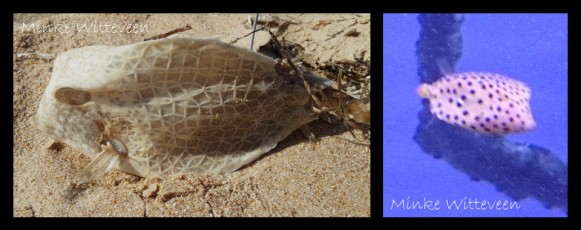Boxfish

While walking the stretch of beach between Robberg Peninsula and Beacon Island I came across several dried out boxfish which spurred me to read up about this group of fish. Boxfish range in size from 15 – 46 cm and are generally solitary fish which spend their time on rocky and coral reefs, and grass beds. They have small, thick lipped mouths which they use to crop algae and small molluscs, crustaceans, sponges, tunicates, worms, and echinoderms. What makes this group of fish particularly unique is their box-like armor made of fused together polygonal, bony plates. It is this armor gives these fish their box-like appearance and their name. The only openings are for the mouth, eyes, gill slits, nostrils, fins and tail, giving a dried up boxfish an unnerving look.
There are pros and cons to being a living tank. On one hand, you become very unpalatable to predators, but on the other hand, you become slow moving. Fish in general use strong muscles to move their tails from side-to-side, but having a rigid frame makes boxfish are unable to do this. Boxfish swim by using sculling movements of their fins which lacks the speedy propulsion seen in other fish (though they do have some use of their tail for forward motion). As such, boxfish have sacrificed speed and agility for increased defence. Another interesting fact about boxfish is that when stressed they secrete a toxin lethal to other fish. Toxins are secreted in a slimy mucus from specialized skin cells. The toxin disperses into the water column where it makes its way into the vulnerable gills of the predator. The toxin causes red blood cells to rupture preventing oxygen from being circulated around the body. Humans eating cooked boxfish can experience severe poisoning. Boxfish advertise their toxicity using bright, beautiful colours and as a result are popular fish to see on a scuba dive. Keep your eyes open for them underwater, as well as washed up and dried out on the beach.
Written by: Minke Witteveen
For more reading:
• Buehler, J. 2014. Boxfish: little fish, big toxins. Accessed: 13-02-2016. URL: www.sydcab.com/category/toxins/
• Heemstra, P. & Heemstra, E. 2004. Coastal fishes of southern Africa. NISC and SAIAB, Grahamstown.




